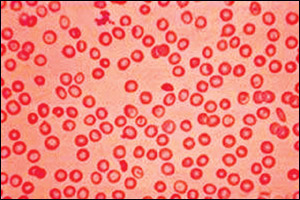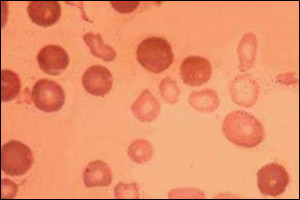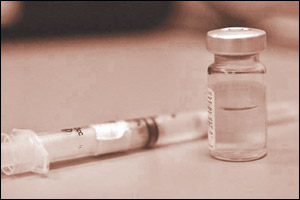|
Health Watch
An easy way to prevent Thalassemia
World Thalassaemia Day: 8-5-2010:
Dr. Shantha Hettiarachchi
The marriage is expressed by the most of Sri Lankans as Bamba ketoo
hati in their words. It means that the marriage is decided through
unseen powers such as Brahma.
|

Children holding hands in an awareness program to prevent
thalassaemia |
Prior to the marriage, matching of the partners will take place
according to their ethnic and religious concepts too. Nevertheless, it
may get revealed that this type of matching, is incomplete when the
couple get a new born baby with hereditary disorders. Hence, a few more
matching of marital partners should be completed to avoid these easily
preventable problems.
Thalassemia represent a higher position in the list of preventable
hereditary disorder through screening, clinical matching and marriage
counseling. It has a long history, over 50,000 years in the world.
Thalassemia is derived from a Greek word of Thalasa means ‘sea’ because
it was found in a valley south of Italy and Greece covered by the
Mediterranean sea.
The Thalassemias are the commonest inherited haematological disorders
and also the commonest single gene disorders in the world population. It
is also a major cause of mortality and morbidity in South East Asian
region. It is a significant burden to the health services and economy of
many countries.
A basic knowledge on blood and anaemia is necessary to understand
about thalassemia. The blood consists of cells and the liquid part of
plasma. The white blood cells, red blood cells and platelets represent
the cellular elements of the blood. A red coloured, oxygen carrying
pigment, called hemoglobin is found in the red blood cells. Hemoglobin
is essential for body metabolism as it carries oxygen to the cells of
every tissues and organs. A person will develop anaemia, when there is a
decrease in the level of hemoglobin in the blood below the reference
level for the age and sex.
|

Thalassaemia minor |
This genetic hemotological disorder of thalassemia is characterized
by absent or decreased production of normal hemoglobin, resulting an
anaemia. The hemoglobin molecule consists of a hem and globin. The
protein moiety of globin synthesis is impaired, as there is a mutation
of the genes in thalassemia. According to these mutations, synthesis of
the main globin chains, namely alpha and beta is markedly reduced.
Eventually, it leads to a decreased production of haemoglobin with
anaemia. Then the disease state is named as beta thalassemia or alpha
thalassemia, depending on the relevant type of globin chain, production
of which is impaired due to this disorder.
There are two forms of thalassemia, called as thalassemia major with
clinical manifestations and thalassemia minor without clinical
manifestations. Thalassemia major is a severe inherited childhood anemia
in which hemoglobin synthesis is highly inadequate. These children are
normal at birth but become grossly anaemic within the first year of life
with failure to grow, poor feeding, intermittent fever and delay in
improving from recurrent infective illnesses.
They need regular blood transfusions in life to avoid fatal
complications and to secure optimum growth and development. As the red
blood cells in the transfused blood are broken down, the iron released
from these cells are accumulated in their body. The overload of iron can
damage the vital organs, such as heart, liver and pancreas to cause
heart failure, liver disease and diabetes. Therefore iron chelation
therapy with the drugs such as Desferrioxamine has to be continued
concurrently with blood transfusion to avoid these complications by
removing extra iron from the body.
|

Thalassaemia major |
The persons with thalassaemia minor, known as carriers of thalassemia
are healthy and normal but some of them can manifest milder degree of
anemia. This carrier stage is commonly discovered while they are
undergoing a test of blood picture for some other circumstances.
The beta thalassemia is the most important form of thalassemia,
causing a major public health problem in many countries. It was
estimated that 1.5 percent of world population are carriers of beta
thalassemia and around 70,000 beta thalassemic babies are born annually.
The alpha thalassemias are commoner than the beta thalassemias but
the consequent public health problems are less as the mild form of the
disease do not produce major disabilities.
Currently, more than 2500 children are living with thalassaemia major
in Sri Lanka. The highest number of patients are reporting in Kurunagala,
Kandy, Anuradhapura and Badulla districts. About one hundred new
patients are accumulating to the total number annually.
The country has to allocate 7 percent to 10 percent from total health
expenditure for the clinical management, necessary for these patients.
It was stated that the expenditure is around ten million rupees in
managing one thalassaemic patient in a lifetime.
|

Prevention is better |
If both partners are thalassemic carriers there will be a 25 percent
chance of giving birth to baby with thalassemia. If the thalassemic
carrier marries a normal partner there will be no risk of getting a
thalassemic baby.
There is no possibility in having a thalassemic baby, when there is a
marriage between a thalassemic patient and a normal partner too.
Therefore, prevention from thalassemia is not a difficult task if the
people have a basic knowledge on these simple scientific facts.
The thalassemia carrier state could be identified by simple blood
tests. It is very important to know whether they are carriers of the
disease prior to marriage, especially when they are living in areas with
high prevalence of thalassemia, such as North central, North Western,
Uva, Central and Western provinces of Sri Lanka.
The one essential act to avoid is the marriage between two
thalassaemic carriers. As the facilities in screening for thalassemia
and counseling are currently available provincially, the public will
have the responsibility to use these services wisely.
May 8 marks the World Thalassemia Day. It should be noted that the
quality of life of the thalassemic patients, is improving from day to
day with the advances in treatment. While giving proper care to the
people who has developed the disease, every body should try their level
best to prevent the disease.
A place for healthy criticism
Nadira Gunatilleke
Criticizing is very common for everyone. Everywhere and every time.
Healthy criticism is allowed in any democratic environment. Therefore,
Health Watch will provide a space for healthy criticism!
|

Every last breath lies on them |
The silent agonies of thousands of innocent patients who faced
`problems’ while obtaining medical treatment and the heartaches of their
loved once should be heard. They should be given an opportunity to
express their experiences. Medical negligence cannot be a prohibited
word.
Doctors are the experts of health and medicines. Patients are there
to follow their medical advice. Hospitals are there to serve the public.
Drug stores and pharmacies are their to sell or issue drugs free of
charge (in the state sector). There are companies which provides
ambulance services, home nursing care and many other health related
services. There are a large number of people who obtain their services.
Almost all of us visit some sort of hospital or similar medical
institutions for various requirements.
During all these processes, mistakes, shortcomings and acts of
negligence can take place. There is a possibility that some of them can
be forgiven and some of them cannot, because it involves with human
life.
There are certain things that we all observed in Sri Lanka during the
past few decades. Some facts, incidents and information came out through
media and some did not due to the pressure put on media by persons and
business establishments. Some got hurt after reading about them while
some were thrilled to see their agonies get publicity through newspapers
and television. Almost all Sinhala newspapers and television stations
report the agonies of innocent patients but not many English newspapers
do so. This is all about some ‘incidents` took place and to be taken
place in our medical institutions time to time.
All human beings feel pain. All people feel bad when their loved once
get affected due to shortcomings, mistakes or negligence by others. All
health professionals get angry and sad when they get bad publicity and
get accused for the things that they have never done and not responsible
for. So what goes wrong? How and where?
One thing is sure when carefully observing the health sector in Sri
Lanka. It is, certain things go wrong sometimes, somewhere and somehow
no matter how hard the health authorities try to offer the best health
care service to the public!
|

Our health is entrusted upon them |
Whenever something happens in the health sector (such as raising
dengue deaths or imputing wrong body parts), many come out with
different types of criticism. Most of them do not have something health
to offer or healthy criticism.
The majority of the critics have their own agendas and use criticism
to push forward those agendas. Some critics criticize because of certain
personal reasons such as hatred, to obtain financial benefits from
interested parties or it may be because of the greed for publicity! No
matter whatever reason it is, it should voice the voiceless and assist
the victims.
Here is one good reason that proves the importance of having healthy
criticism on our health sector. How many incidents of possible medical
negligence was reported in Sri Lankan print and electronic media during
past years or decades?
All of us know a large number of such incidents were reported. There
were incidents when children and adults lost their healthy body parts,
mothers got killed after child birth and infants and school children got
killed after receiving vaccines.
How many such cases were investigated? Maybe all or at least many of
them had been investigated by the relevant authorities. Where are the
results of those hundreds of investigations?
Where are the culprits? It is impossible that not a single culprit
found from hundreds of investigations on hundreds of incidents! Who
protects the culprits and why? Where is the justice? What is the
situation of the victims?
This issue will be discussed in length next week. Until then the
whole issue can be described in a single sentence. It is Horage ammagen
pena aseema! (inquire about the thief from his mother!)
Maybe this is the reason why no culprit found so far from the
hundreds of investigations conducted on hundreds of `medical negligence
incidents’ took place in Sri Lanka during the past.
Raising awareness of speech delay in children
Ishara Jayawardane
Speech delay in children is a serious problem in Sri Lanka that needs
to be looked into. It is not a problem that should be ignored since
ignoring this problem will not bring any relief or do any good either to
the patient or his/her family. It is a distressing problem and immediate
treatment must be administered.
|

Charts showing some of the lab results for speech delay |
People are not aware of such type of disorders. They don’t know there
is something called speech therapy that can help them. So basically what
we do here is, hearing testing. Other than that we have speech therapy
for all the kinds of communication disorders such as language problems
after stroke and stammering. We have special education programs for
children who need special education. Not the normal education”, Speech
Language Pathologist Buddhima Samaraweera said.
Samaraweera outlined the problem by saying that usually the child
starts talking at one year to one and a half years. What happens here is
even after two years mothers think the child will talk later. Speech
delay can be for many reasons, can be because of autism or mental
retardation. If the child has any delay, if the child is not speaking at
all even after one year there not even a single word then you should go
to a paediatrician. Some children have normal speech delay they will
catch up later. But some children are in the early stage of some kind of
problem and that is not something to be ignored.
In the first year the first word should be there. It is a process. In
three months the motor development takes place and at six months they
start babbling. It is a critical point. Children with autism don’t have
that kind of babbling. If the child is not babbling that could be a
problem. In 10-11 months they start speaking jargon. Jargon should be
there.
What is Autism? “Autism is spectrum. It is a pervasive development
disorder. It is a life long disorder. What we can do is we can modify
things. You cannot cure autism. They have problems with adjusting to
society and they cannot socialize. Usually we diagnose autism after
three years.
There are also other forms of speech disorders. One is mental
retardation. The other is cluttering. That is when they speak very fast
and the listener cannot understand what the person is saying. Even the
removal of the larynx after cancer can cause speech disorder”, explained
Samaraweera.
Voice disorders can be cured. Before they go to surgery they come for
speech therapy. If the speech therapy is successful they don’t have to
go for surgery. For stammering mostly they improve but there is a chance
for recurrence. So when the disorder recurs all they have to do is
attend a few sessions.
Hearing loss can also be linked to speech problems. Because our
speech is clear because we get feedback. So when they can’t hear they
can’t get feedback and so they can’t correct themselves.
“We should not ignore. If the child is not speaking at one year three
months then they should see a doctor. If they are not learning new words
at a good rate then they should see a speech therapist”, Samaraweera
added. Samaraweera also pointed out that speech disorder can be the
cause of mental disorder.
They can have language disorders. Children should be regularly
treated on speech therapy in weekly session.
“Speech therapy is a team effort. Take mental disorder. We should
know what is going on in his life. That you can get from psychiatrists.
So we should have that kind of communication. We are a team otherwise we
are not able to do it alone, illustrated Samaraweera.”
(The writer is Speech Language Pathologist of the Ratmalana
Audiology Centre).
|



